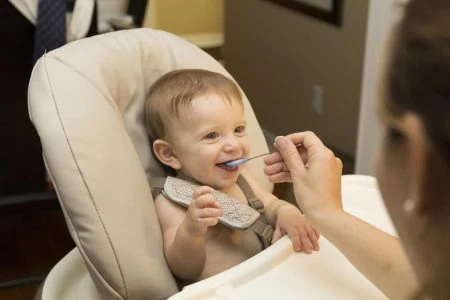Let’s be honest; eating a hot meal with two hands feels like a distant memory once you have a newborn. Life gets significantly easier once your little one can join you at the table in their own seat. But rushing this milestone isn’t just uncomfortable for the baby; it can be a safety hazard.
In this guide, we will break down the telltale signs that your baby is strong enough for a high chair, the “90-90-90” rule for comfort, and the safety tips you need to know before that first spoonful of solids.
Key Takeaways
- Timeline: Most babies are physically ready for an upright high chair around 6 months old, coinciding with the start of solid foods.
- Readiness Signs: Look for strong head control, a straight neck, and the ability to sit with minimal support (tripod sit).
- The 90-90-90 Rule: For optimal stability and safety, a baby’s hips, knees, and ankles should all be bent at a 90-degree angle.
- Safety First: Always use the safety harness, never leave the baby unattended, and ensure the chair is on a stable surface away from walls or counters.
How To Tell if Your Baby Is Ready for an Upright Chair
While every child develops at their own pace, babies generally become ready to sit upright between four and six months of age. However, for feeding purposes, this usually aligns closer to the six-month mark.
So, how do you know if they are truly ready, or if they just look cute propped up? You need to look for core stability.
Ensure your baby’s head and neck are steady without needing pillows for support. In the early stages, a baby might hold their head up for a minute or two but quickly tire. If you see their head bobbing, flopping to the side, or their body slumping down into the seat, their muscles aren’t quite there yet.
When seated, your baby’s shoulders should remain straight. Their arms should be free to move, reach, and grab. If a baby has to use their hands to prop themselves up (preventing them from tipping over), they cannot use those hands to explore food.
If your baby cannot maintain an upright position without significant help, keep practicing on the floor with your supervision. They build strength quickly!
Important Note
To understand this, try tucking your chin to your chest and looking at your lap. Now, try to swallow. It is difficult and uncomfortable. This is why posture is non-negotiable before you attempt to feed your baby solids.
It is helpful to review these developmental milestones so you know exactly what to watch for before making the switch (1).
Bottom line: If your little one can sit up with very little support, holds their head steady, and stops slumping, they are likely ready for a high chair.
The “90-90-90” Rule and Positioning
Beyond just sitting up, proper ergonomics in a high chair can prevent fussiness and choking. Pediatric physical therapists and feeding experts recommend the “90-90-90” rule.
When your baby is in the chair, check for the following:
- Hips: Hips should be at a 90-degree angle to the torso (sitting right up against the back of the seat).
- Knees: Knees should bend at a 90-degree angle at the edge of the seat.
- Feet: Ankles should be at a 90-degree angle with feet resting flat on a footrest.
If your baby’s feet are dangling, they lack stability. Think of it like sitting on a barstool without a foot rail; eventually, your lower back hurts and you feel wiggly. A footrest provides the feedback their body needs to focus on eating rather than balancing.
Safely Transitioning to a High Chair
Once you have determined they are ready, follow these high chair safety tips to keep mealtimes happy and accident-free:
- Check Certifications: Ensure the chair has a JPMA (Juvenile Products Manufacturers Association) sticker, indicating it meets ASTM safety standards.
- Inspect Second-Hand Gear: If you are using a hand-me-down, check the model name and manufacture date against the government recall database at www.recalls.gov. Vintage wooden high chairs often lack modern safety features like a crotch post or 5-point harness.
- Register Your Product: Fill out the registration card so the manufacturer can contact you immediately if a safety issue is discovered later.
- Do a Dry Run: Before putting the baby in, make sure you know how the tray snaps on, how the harness buckles, and how the legs lock. Fumbling with a hungry baby in your arms is stressful!
- Check for Damage: Give the chair a quick once-over before each use to ensure the tray is secure and straps aren’t frayed.
- Positioning in the Room: Keep the high chair far enough from the table, counters, or walls so your baby cannot push off against them and tip the chair backward.
- Buckle Up Every Time: Always use the 3-point or 5-point harness. The tray is not a restraint. Most high chair injuries happen when a baby tries to stand up or slide out under the tray.
- Stay Close: Never leave your baby unattended in a high chair. Choking is silent, and accidents happen in seconds. Have your baby utensils, wipes, and food ready before you buckle them in.
Finding the Right High Chair
The best high chairs vary significantly in design. Here is how to distinguish between the two main categories:
Reclining High Chairs
Some chairs offer a reclining feature. These can be used for bottle feeding or simply letting the baby sit at the table with the family before they have full neck control.
However, never feed a baby solid food in a reclined position. The recline is strictly for resting or bottle feeding (though holding your baby for bottles is still preferred for bonding). You must move the seat to the fully upright position before offering purees or finger foods.
Upright High Chairs
Once your baby is sitting independently, you have more options, including traditional chairs or space-saving high chairs that strap onto dining chairs.
Look for an easy-to-clean high chair with a broad, stable base and a footrest. You will likely use this gear for at least two years, so durability matters.
FAQs
Choose What Works For You
If your baby gets fussy during dinner and wants to be part of the action before they are physically ready to eat, a high chair with a recline function can be a lifesaver. It lets them see you and play safely while you finish your meal.
However, once you start that exciting journey of solid foods, remember: upright is the only way to go.
Whether you choose a fancy adjustable model or a simple plastic seat, the most important factors are safety and stability. Ensure your baby is buckled in, supervise them constantly, and enjoy these messy, memorable family meals!











